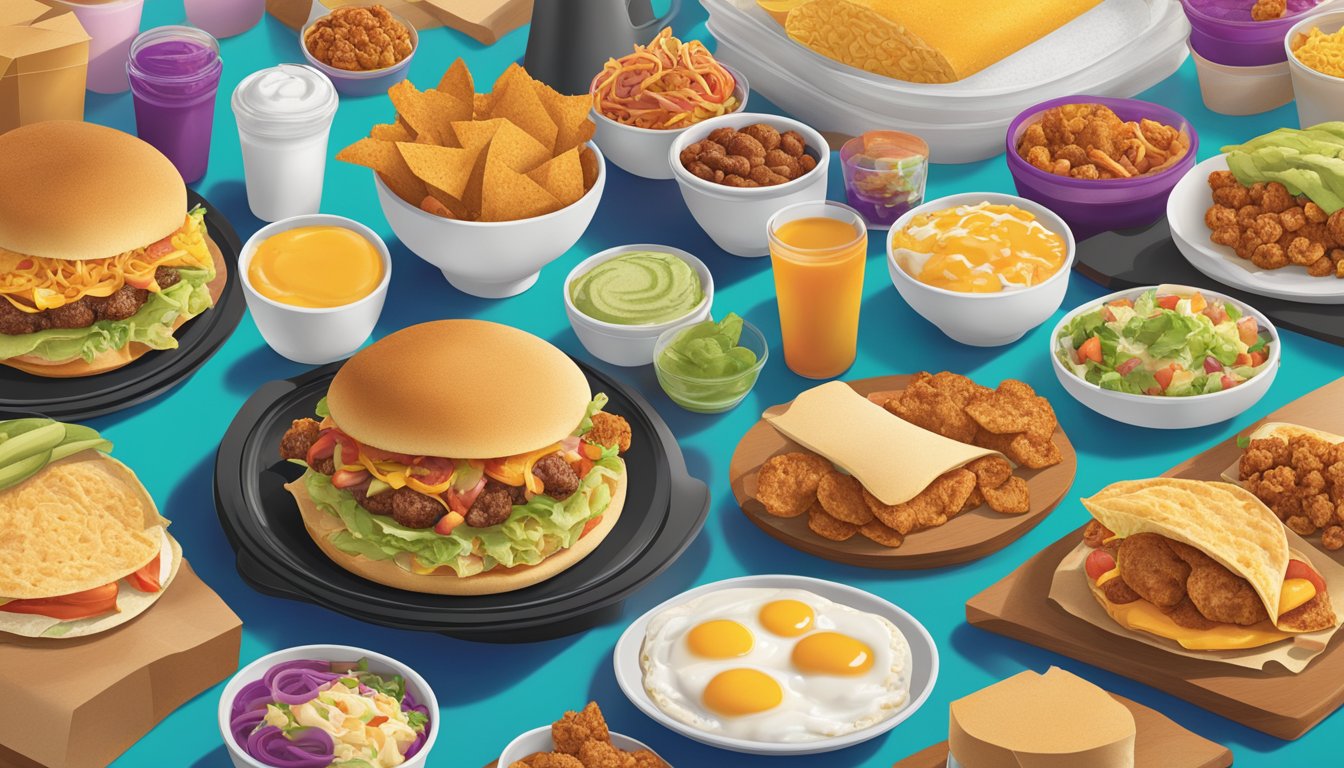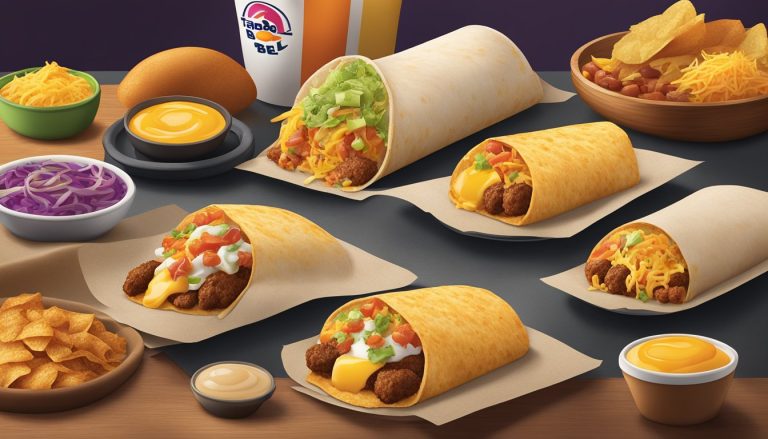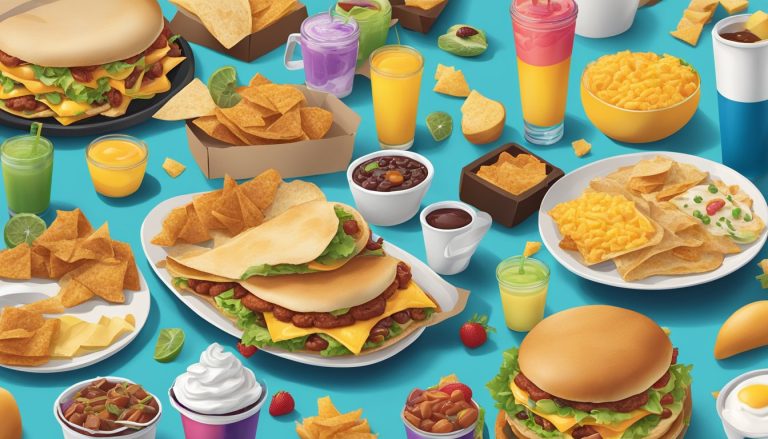Taco Bell’s foray into the breakfast market on March 27, 2014 marked a significant shift in the fast food industry. The chain’s decision to introduce a unique morning menu challenged traditional breakfast offerings and sparked a new era of innovation among competitors.
Taco Bell’s bold move to offer breakfast items like the Waffle Taco and Crunchwrap demonstrated that fast food chains could successfully expand beyond their typical operating hours and menu offerings. This expansion not only provided customers with more diverse options but also opened up a new revenue stream for the company.
The introduction of Taco Bell’s breakfast menu was supported by the brand’s largest marketing campaign to date, signaling the importance of this strategic move. Nearly five years after its launch, Taco Bell’s breakfast continues to thrive, proving that unconventional approaches can lead to lasting success in the fast food industry.
Taco Bell’s Entry Into the Breakfast Market
Taco Bell’s foray into breakfast revolutionized fast food morning offerings. The chain introduced unique menu items that set it apart from traditional breakfast fare, marking a significant shift in the industry.
History of Taco Bell’s Breakfast Rollout
Taco Bell launched its nationwide breakfast menu on March 27, 2014. This move came after years of testing and development, as the company sought to capture a share of the lucrative morning food market.
The rollout was supported by Taco Bell’s largest marketing campaign to date. It aimed to challenge established breakfast players like McDonald’s and Burger King.
Taco Bell’s decision to enter the breakfast arena was driven by the success of other fast food chains in this segment. The company recognized the potential for growth and revenue expansion.
The Evolution of Taco Bell’s Breakfast Menu
Taco Bell’s breakfast menu debuted with innovative items that blended Mexican-inspired flavors with traditional morning fare. The Waffle Taco, a signature launch item, featured a folded waffle filled with scrambled eggs, cheese, and bacon or sausage.
Another popular offering was the A.M. Crunchwrap, a breakfast twist on Taco Bell’s classic Crunchwrap. It combined scrambled eggs, hash browns, cheese, and bacon or sausage in a grilled tortilla.
The menu also included breakfast burritos, offering a familiar format with Taco Bell’s unique flavors. For those with a sweet tooth, Cinnabon Delights provided a dessert-like option.
Over time, Taco Bell refined its breakfast menu based on customer feedback and sales performance. Some items were discontinued while new ones were introduced to keep the offerings fresh and appealing.
Impact of Breakfast on Taco Bell’s Growth and Market Share
The introduction of breakfast significantly boosted Taco Bell’s sales and market share. In the years following the launch, breakfast accounted for a growing percentage of the chain’s overall revenue.
Taco Bell’s unique take on breakfast attracted new customers and increased visit frequency among existing patrons. This helped the company compete more effectively against other fast food chains.
The success of the breakfast menu also led to extended operating hours at many Taco Bell locations. Some restaurants began opening earlier to serve the morning crowd.
Taco Bell’s breakfast innovation sparked a response from competitors, leading to menu updates and marketing pushes across the fast food industry. This increased competition in the breakfast segment benefited consumers through more choices and promotional offers.
Influence of Breakfast Items on Fast-Food Industry Standards
Breakfast offerings have become a critical battleground for fast-food chains, reshaping industry standards and consumer expectations. The introduction of diverse morning menus has sparked innovation and competition across the sector.
Rising Demand for Fast-Food Breakfast
Fast-food breakfast sales have shown significant growth, reaching $31.7 billion in 2012 with an average annual increase of 4.8% since 2007. This surge in demand has prompted chains to expand their morning offerings. McDonald’s Egg McMuffin set an early benchmark for breakfast sandwiches, inspiring competitors to develop their own signature items.
Taco Bell entered the breakfast market with unique offerings like the Waffle Taco, challenging traditional morning fare. Their bold approach attracted attention from customers seeking alternatives to standard breakfast sandwiches and burritos.
Comparative Analysis with Competing Fast-Food Breakfasts
McDonald’s long-standing dominance in fast-food breakfast faced new competition with Taco Bell’s entry. Taco Bell’s innovative menu items, such as breakfast burritos with Mexican-inspired flavors, provided a distinct alternative to conventional options.
The success of Taco Bell’s breakfast launch was notable, with then-CEO David Novak highlighting it as one of the few successful breakfast introductions in quick-service restaurant history. This achievement prompted other chains to reevaluate their morning menus.
McDonald’s responded by enhancing its coffee program and expanding all-day breakfast options. This strategic move aimed to maintain its market share against emerging competitors.
Implications of Taco Bell’s Breakfast Options for the Industry
Taco Bell’s breakfast innovation set new standards for creativity in the fast-food industry. Their approach demonstrated that customers were open to non-traditional morning menu items, encouraging other chains to experiment with unique offerings.
The introduction of breakfast items like the Waffle Taco pushed boundaries and sparked a trend of fusion breakfast foods. This shift influenced industry-wide menu development, with chains incorporating more diverse flavors and ingredients into their morning lineups.
Taco Bell’s success also highlighted the importance of marketing in launching breakfast menus. Their campaigns, including commercials directed by Oscar winner Errol Morris, set a new bar for breakfast promotions in the fast-food sector.
Consumer Preferences and Breakfast Innovation
Taco Bell’s breakfast menu launch marked a significant shift in fast food breakfast offerings. The company’s innovative approach tapped into changing consumer tastes and preferences, particularly among younger demographics.
Adaptation to Changing Consumer Taste
Millennials drove demand for unique breakfast options beyond traditional fare. Taco Bell recognized this trend and crafted menu items that appealed to adventurous palates. The Waffle Taco and Biscuit Taco exemplified this strategy, combining familiar breakfast elements with Taco Bell’s signature Mexican-inspired flavors.
These novel creations resonated with consumers seeking bold, unconventional breakfast choices. Taco Bell’s offerings stood out in a market dominated by standard egg sandwiches and pancakes.
The Role of Innovation in Taco Bell’s Breakfast Success
Innovation played a crucial part in Taco Bell’s breakfast venture. The Breakfast Crunchwrap became a standout item, merging the chain’s popular crunchwrap concept with morning ingredients.
Taco Bell’s R&D team focused on portability and convenience, key factors for on-the-go consumers. They developed hand-held items that were easy to eat during commutes or at work.
The company’s willingness to experiment and iterate based on customer feedback contributed to its breakfast success. Taco Bell continuously refined its menu, introducing new items and improving existing ones to meet evolving consumer preferences.
Marketing Strategies for the Breakfast Daypart
Taco Bell’s foray into the breakfast market required innovative marketing approaches to capture consumer attention and drive sales. The company employed a mix of traditional advertising and digital engagement tactics to establish its presence in the competitive breakfast daypart.
The Role of Advertising in Taco Bell’s Breakfast Promotion
Taco Bell launched a bold advertising campaign to introduce its breakfast menu. The company invested heavily in television commercials, showcasing its unique offerings like the Waffle Taco and A.M. Crunchwrap.
Billboard advertisements and in-store promotions complemented the TV spots, creating a multi-channel approach. Taco Bell strategically timed these ads to air during peak breakfast hours and popular morning shows.
The campaign’s tone was playful and irreverent, aligning with Taco Bell’s brand identity. This approach helped differentiate Taco Bell from traditional breakfast competitors and appealed to younger demographics.
Digital Marketing and Consumer Engagement
Taco Bell leveraged social media platforms to generate buzz around its breakfast items. The company created hashtag campaigns and encouraged user-generated content, fostering online conversations about its new menu.
Interactive mobile apps allowed customers to easily order breakfast items and receive promotional offers. Taco Bell also used geotargeted ads to reach consumers near its locations during morning commute hours.
Email marketing campaigns kept subscribers informed about new breakfast items and limited-time offers. The company analyzed digital engagement metrics to refine its marketing strategy and improve its sales mix in the breakfast daypart.
Taco Bell’s digital efforts aimed to increase its market share by targeting tech-savvy millennials and Gen Z consumers who were more likely to try non-traditional breakfast options.
Operational Considerations for Serving Breakfast

Introducing breakfast service requires careful planning and execution for fast food chains. Key factors include menu development, operational adjustments, and addressing franchisee concerns.
Menu Flexibility and Breakfast Hours
Taco Bell’s breakfast menu combines familiar morning flavors with their signature Mexican-inspired offerings. Items like the Breakfast Crunchwrap and Waffle Taco aim to differentiate from competitors. Breakfast hours typically run from 6 AM to 11 AM, allowing flexibility for early risers and late sleepers.
Menu boards and kitchen equipment need modification to accommodate new items. Staff require training on breakfast-specific preparation techniques. Some locations may struggle with extended operating hours, especially in areas with limited morning foot traffic.
Challenges for Franchisees and Quick-Service Restaurants
Franchisees face increased costs when adding breakfast service. New equipment purchases, additional staff, and extended operating hours impact profitability. Training programs must be developed to ensure consistent quality across locations.
QSRs must balance speed of service with food quality during the breakfast rush. Efficient kitchen layouts and streamlined processes are crucial. Some franchisees may be hesitant to invest in breakfast due to uncertain returns and increased operational complexity.
Supply chain adjustments are necessary to ensure fresh ingredients are available for morning prep. QSRs must negotiate with suppliers for competitive pricing on breakfast-specific items.
Future Trends in Fast Food Breakfast Offerings
Fast food chains are adapting their breakfast menus to meet changing consumer preferences and capitalize on growing breakfast sales. Innovation and convenience will drive upcoming shifts in morning meal offerings.
Expansion of All-Day Breakfast Options
Some fast food restaurants are reconsidering all-day breakfast due to its popularity. While McDonald’s discontinued it in 2020, other chains may test extended breakfast hours. Taco Bell could potentially expand its breakfast menu availability beyond morning hours. All-day options may focus on portable items like breakfast burritos or sandwiches that are easy to prepare alongside regular menu items.
Chains may also introduce breakfast-inspired dishes to their standard menus. This could include items like breakfast pizzas or burgers topped with eggs and hash browns. Such hybrid offerings would allow restaurants to tap into breakfast flavors throughout the day without major operational changes.
Emerging Breakfast Foods and Consumer Trends
Fast food breakfast menus will likely incorporate more global flavors and health-conscious options. Taco Bell’s Mexican-inspired breakfast items exemplify this trend toward bolder, more diverse morning fare. Chains may introduce items like breakfast banh mi sandwiches or shakshuka-inspired dishes.
Plant-based alternatives will become more prevalent in fast food breakfast offerings. Egg substitutes, plant-based sausages, and dairy-free options will cater to health-conscious and vegan consumers. Chains may also emphasize protein-rich options to appeal to fitness enthusiasts.
Creative twists on classics will continue to drive innovation. This could include unique hash brown creations, breakfast-inspired desserts, or savory oatmeal bowls. Fast food restaurants will aim to surprise customers with unexpected flavor combinations and textures in familiar breakfast formats.




